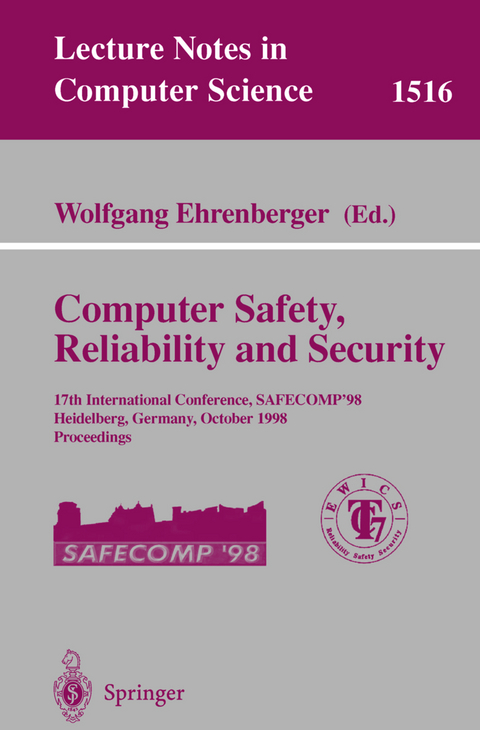
Computer Safety, Reliability and Security
Springer Berlin (Verlag)
978-3-540-65110-9 (ISBN)
Prof. Dr. Wolfgang Ehrenberger unterrichtet an der FH Fulda und ist Mitglied europäischer Organisationen, die sich mit Sicherheitsfragen in der Software-Entwicklung beschäftigen.
Formal Methods I - Analysis and Specification.- CoRSA - A Constraint Based Approach to Requirements and Safety Analysis.- An Agenda for Specifying Software Components with Complex Data Models.- Safety in Production Cell Components: An Approach Combining Formal Real Time Specifications and Patterns.- Safety Properties Ensured by the OASIS Model for Safety Critical Real-Time Systems.- Linking Hazard Analysis to Formal Specification and Design in B.- Management and Human Factors.- Controlling Your Design through Your Software Process.- Operator Errors and Their Causes.- Security.- A Performance Comparison of Group Security Mechanisms.- Towards Secure Downloadable Executable Content: The JAVA Paradigm.- Model and Implementation of a Secure SW-Development Process for Mission Critical Software.- Impact of Object-Oriented Software Engineering Applied to the Development of Security Systems.- Medical Informatics.- "Profit by Safety" or Quackery in Biomedical Information Technology?.- Formal Methods II - Languages and Verification.- Towards Automated Proof of Fail-Safe Behavior.- Verifying a time-triggered protocol in a multi-language environment.- Methods and Languages for Safety Related Real Time Programming.- ANSI-C in Safety Critical Applications Lessons-Learned from Software Evaluation.- Applications.- A Structured Approach to the Formal Certification of Safety of Computer Aided Development Tools.- Applying Formal Methods in Industry The UseGat Project.- Increasing System Safety for By-Wire Applications in Vehicles by Using a Time Triggered Architecture.- Fault-Tolerant Communication in Large-Scale Manipulators.- Distributed Fault Tolerant and Safety Critical Applications in Vehicles - A Time-Triggered Approach.- Model Checking Safety Critical Software with SPIN: anApplication to a Railway Interlocking System.- EURIS, a Specification Method for Distributed Interlockings.- Object Oriented Safety Analysis of an Extra High Voltage Substation Bay.- Formal Methods III - Petri Nets.- Integration of Logical and Physical Properties of Embedded Systems by Use of Time Petri Nets.- Safety Verification of Software Using Structured Petri Nets.- Reliability.- Refinement of Safety-Related Hazards into Verifiable Code Assertions.- Conceptual Comparison of two Commonly Used Safeguarding Principles.- A Holistic View on the Dependability of Software-Intensive Systems.- Verifying Integrity of Decision Diagrams.
| Erscheint lt. Verlag | 23.9.1998 |
|---|---|
| Reihe/Serie | Lecture Notes in Computer Science |
| Zusatzinfo | XVI, 404 p. |
| Verlagsort | Berlin |
| Sprache | englisch |
| Maße | 155 x 235 mm |
| Gewicht | 593 g |
| Themenwelt | Informatik ► Theorie / Studium ► Kryptologie |
| Schlagworte | Computer Safety • Computer Safety, • Computersicherheit • Dependable Computing • Formal Method • formal methods • Hardcover, Softcover / Informatik, EDV/Informatik • HC/Informatik, EDV/Informatik • HC/Informatik, EDV/Programmiersprachen • Medical Informatics • Petri net • Reliability • Secure Systems • security • verification |
| ISBN-10 | 3-540-65110-1 / 3540651101 |
| ISBN-13 | 978-3-540-65110-9 / 9783540651109 |
| Zustand | Neuware |
| Haben Sie eine Frage zum Produkt? |
aus dem Bereich


